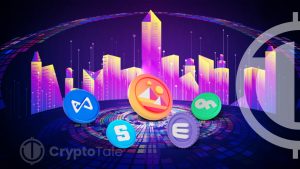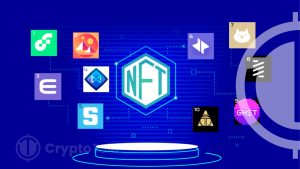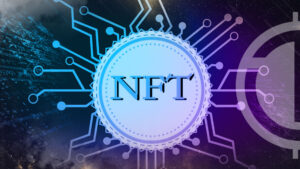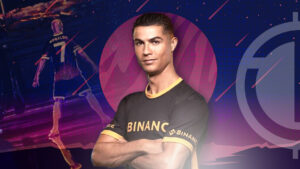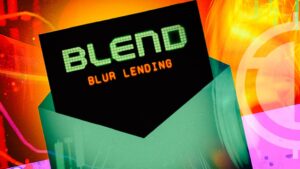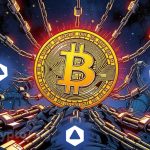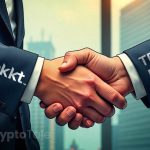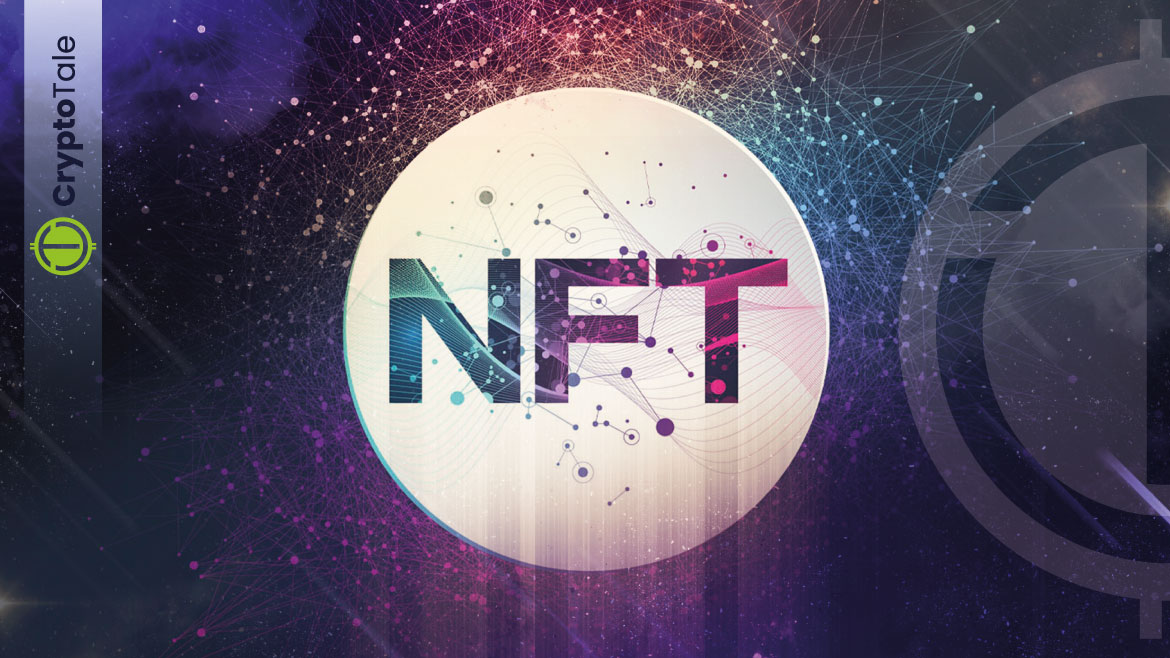
Non-fungible tokens, or NFTs for short, are all the hype in the blockchain space at the moment. They gained a lot of attention when they gave artists around the world a chance to protect and market their works of art online during the Covid-19 global lockdowns.
This article will take at what NFTs are, what NFT marketplaces are, some of the most popular NFTs and their fees, and much more.
Before we proceed, let’s take a look at what NFTs are exactly and discuss the technology that is powering them.
NFTs Explained
A non-fungible token, or NFT, can be a digital representation of anything. This can include data, information, a real-world object, clothing, music, or pieces of art. These non-fungible tokens are unique, and are the original copy of the item that they represent.
Unlike most cryptocurrency coins, they cannot be replaced by another coin in the same cryptocurrency. For example, a Bitcoin coin can be replaced with another. This is why a Bitcoin, or any other cryptocurrency, coin is referred to as fungible, and why a NFT is non-fungible.
Now that we have covered why NFTs are non-fungible, let’s take a look at the pioneering technology that has made NFTs possible; blockchain technology.
The price of non-fungible tokens reflects the demand for what the token represents, similar to a cryptocurrency. A NFT can be thought of as an authentication and ownership verification method for digital media.
What separates NFTs from cryptocurrencies is that each NFT has a distinct value, hence why it is referred to as non-fungible. Meaning, a NFT does not hold the same value as any other similar NFT, as is the case for ETH and BTC for example.
What is Blockchain Technology?
As mentioned, blockchain technology is the technology that has made NFTs possible. So what exactly is a blockchain? Well, a blockchain is a decentralized digital ledger. What this basically means is that the control and maintenance of a blockchain is not the responsibility of a handful of people or a central entity like an organization or an individual.
Instead, a blockchain is powered by the people that use it! Every person that uses a blockchain, and runs a computer on the network, makes a blockchain a distributed and global network.
This is a very high level overview of what a blockchain is, but it is important that we go over it to understand how NFTs came to be.
By utilizing the privacy, transparency, autonomy, and decentralization of blockchain technology, NFTs can be used to represent anything digitally as well as verify ownership of these digital representations and make them transferable; feats that were very difficult to achieve before the invention of blockchain technology.
What Are NFT Marketplaces?
NFT marketplaces are platforms where users can store, display, trade, and in some cases, mint, NFTs. These marketplaces are to NFTs what Amazon is to goods. In order to access and use these types of marketplaces, you will have to set up a crypto wallet, deposit some coins in your new wallet, and set up a user account.
A Crypto Wallet
One of the first things that you will have to do is choose a crypto wallet that is compatible with the blockchain network that supports the NFTs that you wish to purchase. For instance, if you plan on purchasing or selling NFTs based on the Ethereum blockchain platform, you will need to use a wallet that is compatible with the Ethereum network.
Deposit Coins In Your Wallet
You will then need to pre-fund your wallet before buying, listing or minting an NFT. Once again, you will need to find out which cryptos are supported by the marketplace that you intend on using.
A User Account
Lastly, you need to set up an account on the particular marketplace that you want to purchase NFTs from.
Something that you need to be aware of is that for the most part, listing and creating NFTs on an NFT marketplace platform incurs a blockchain network fee. These fees will vary depending on which blockchain-based system you decide to use.
Top NFT Marketplaces
OpenSea
Having launched in 2017, OpenSea is regarded as a legacy platform. It is also among the largest NFT marketplaces active today. The platform plays host to many popular NFTs, that include art, music, trading cards, photography, trading cards and virtual worlds.
THe core list of cryptos that are supported on OpenSae are Ethereum (ETH), Solana (SOL), and USD Coin (USDC). One important thing is that you are not able to use fiat currencies such as the U.S. dollar or euros.
Fortunately, OpenSea is very user-friendly for beginners. You can easily set up a free account within minutes and start browsing NFTs immediately. You can even create NFTs on their platform.
When it comes to costs, OpenSea charges a fee of around 2.5% of every transaction. You will also need to pay the gas fee for completing NFT transactions with Ethereum, which are the transaction fees that are paid to miners.
If you are looking to avoid the gas fee, you can opt to buy and sell NFTs with Polygon. Just make sure that the NFT item of interest displays the Polygon logo.
Rarible
Rarible allows users to buy and sell art, collectibles, video game assets and NFTs. You can deal on Rarible’s platform with either Ethereum, Tezos, or Flow.
The platform charges a flat 2.5% fee on every transaction, on top of any gas fees. One nice feature of the platform is that you can buy NFTs using a credit card, thus enabling transactions in fiat currencies.
An interesting aspect of Rarible is that the Rarible team has created its own native token called RARI. Holders of this token get to vote on company decisions such as company policies, instead of in-house management deciding on these policies.
Furthermore, Rarible announced its partnership with Adobe in 2021 to make it easier to verify and protect the metadata for digital content.
NBA Top Shot
For all major basketball fans, the NBA Top Shot marketplace lets you buy NFTs of great moments in basketball history.
Using the platform, you can buy video clips, play highlights and art for both the NBA and the WNBA. However, some of these moments are not cheap. For instance, a LeBron James slam dunk video fetched $208,000 in February of 2021.
The NBA organization built and manages this NFT marketplace, and they have exclusive rights to these video clips, Plus, you have the comfort of knowing that you are dealing with a large and reputable organization.
The NBA Top Shot marketplace is one example of major companies getting in on this trend. Other companies include the DraftKings Marketplace and the Associated Press. Even GameStop plans to launch an NFT marketplace this year.
Users are able to purchase Moment NFTs with credit/debit cards or select cryptos, such as Bitcoin, Ethereum, Bitcoin Dash, DAI or USDC. Of course, there are fees added to every purchase regardless of whether you’re purchasing an NFT with your card or with crypto.
Binance
The largest crypto exchange by trading volume, and it added its own NFT marketplace in 2021. The international crypto exchange is one of the many other industry players that is entering into the NFT sector.
Binance NFT offers the typical digital assets found on other major platforms, such as collectibles, artworks, and gaming items.
One major advantage of Binance NFT is that it charges really low fees.The platform only deducts a 1% trading fee. In addition to the low fees, the platform is also user-friendly and is built using technology and layouts similar to that as their exchange platform. Binance has the added advantage of running its own blockchain.
Nifty Gateway
Nifty Gateway is known for hosting expensive and exclusive NFT sales, including “The Merge” by the digital artist Pak, which sold for $91.8 million. The platform made news when it was acquired by Gemini in late 2019, which is run by the Winkelvoss twins.
This marketplace focuses on artwork, especially artwork from celebrity digital artists. To drive demand, Nifty Gateway employs an “open editions” system. When a new type of NFT comes out, you can only buy editions for just a limited time.
This is another platform that allows you to make purchases with your credit card, and could be the way to go if you are looking to make a large investment in NFTs and want access to higher-end options.
SuperRare
SuperRare is a high-end NFT art marketplace that positions itself in the NFT ecosystem as an art gallery. This marketplace doesn’t accept “meme style” NFTs, and is highly selective when it comes to the NFT submissions process.
Given the fact that SuperRare spends so much time reviewing work before it’s available for sale, investors can rest assured when it comes to the quality of the NFTs available on the platform.
For their services, SuperRare does charge a 15% fee for the first time that an NFT is sold on the primary market. There is also a 3% flat fee for every transaction, which has to be paid by the buyers.
SuperRare could be a good choice for someone that is in search of high-end NFT artwork, especially pieces with a more classical style.
The NFT Hype
The hype around NFTs started when art began being turned into NFTs. When this happened, it brought the fairly large collector’s market to the blockchain space. It also contributed to cryptocurrency and blockchain’s existing speculator’s market.
Art speculators and collectors from around the world could now collect, purchase, and sell artworks on the blockchain network. They could also do so anonymously and securely, plus verify that they own the artwork. All of this was considered extremely difficult, if not impossible, to accomplish before blockchain technology.
After NFTs made their way to the art world, companies started exploring what else NFTs could be used for. This is one of the contributing factors to the creation of a metaverse. By using NFTs, in-game assets can now be transferable. So anyone can buy, exchange, and sell in-game assets with other players in the metaverse.
This transferability of in-game assets introduced the play-to-earn space to the world. Meaning, anyone can now play blockchain-powered games and earn money from doing so.
As you can see, the creation of NFTs created a snowball effect. From making its way to the art world and giving artists a way to earn money for their work during lockdown, to now giving anyone around the world the ability to earn by playing games in the play-to-earn space.
The innovation around NFTs has been a focal point for the majority of companies in the blockchain space as each of them is eager to keep the hype around NFTs going.
Is the Hype Around NFTs Justified?
To determine whether or not any form of hype in the blockchain and cryptocurrency space is justified, simply look at the utility around what is being hyped. With this in mind, NFTs solved a major problem in the art world.
They give artists around the world an online platform where their art pieces could not be replicated. In this online platform, artists can also reach a wider audience in the art speculation and collection space, as well as verify that the art work they were publishing was the original. This scenario on its own gives NFTs a lot of utility.
The utility of NFTs is further expanded in the play-to-earn space. People can now play blockchain-powered games and earn money for doing so. This is mainly through the trading of in-game assets in these games, and these assets are all NFTs.
The timing of the debut of the play-to-earn space was perfect because it was during the Covid-19 pandemic. As people around the world lost their jobs due to Covid-19, they turned to NFTs and blockchain games to make money, and they were not disappointed.
Another big fact around NFTs is that they are slowly becoming the new blockchain-enabled store of value. Before NFTs, the biggest public blockchains were used as a storage of value as people transferred portions of their fiat currency values into cryptocurrencies like Bitcoin and Ethereum.
However, the price of NFT in-game assets is now proving to be less volatile than these large cryptocurrencies. This makes NFT in-game assets a more stable storage of value.
As you can see, the utility of NFTs is already there. With the intense innovation and exploration around NFTs, their utility will only continue to increase. Maybe the hype around NFTs is a bit much for the amount of utility the technology has at the moment, but the market is always excited with new technology that has potential.
If the current rate of innovation around NFTs continues, we could see the closing of the small gap that exists between the technology’s utility and its hype.
Top NFTs And Collectibles
There are several types of NFTs, but the most popular categories are art, music and collectibles. Some of the biggest names in the music industry who have created NFTs include Grimes, Kings of Leon, Steve Aoki and 2 Chainz.
A lot of artists who use digital media as the medium for their art have been drawn to NFTs, such as Jon Noorlander, Mike Greg and Beeple. Even the public company Score Media and Gaming Inc. (SCR) has started covering NFTs in its weekly show Mint Condition.
One of the first big NFTs was a cryptocurrency collectible called CryptoKitties. These digital cats were released back in 2017 and are collectible in a way similar to Beanie Babies. Other unique collectibles that have entered the market include NBA Top Shots, Cryptopunks, and in-game assets for video games and the metaverse.
Pros And Cons of NFTs
NFTs clearly benefit artists who produce digital media. Prior to the invention of NFTs, it was extremely difficult to verify the authenticity of digital media, since anyone would be able to copy and paste the file. However, not all NFTs are valuable. Let’s take a look at some of the pros and cons of NFTs.
Pros
- Non-fungible tokens have simplified the buying and selling process of online digital media.
- By utilizing blockchain technology, anyone can easily verify the authenticity and ownership of the digital media.
- NFTs make collectibles like trading cards more interactive and engaging.
Cons
- The NFT craze has made prices for some collectibles extremely expensive, with some costing more than they are worth.
- A person’s NFTs are at risk of being stolen in a hack if they are not stored securely.
To Recap
A non-fungible token, or NFT, can be a digital representation of anything. This can include data, information, a real-world object, clothing, music, or pieces of art. These non-fungible tokens are unique, and are the original copy of the item that they represent.
The demand for NFTs grew exponentially during the Pandemic and saw prices for all types of NFTs, including meme-type NFTs, reach all-time highs.
NFT marketplaces are platforms where users can store, display, trade, and in some cases, mint, NFTs. These marketplaces are to NFTs what Amazon is to goods. Some of the biggest and most well-known NFT marketplaces in the market are OpenSea, Rarible, and Superare. Each of these NFT marketplaces charge varying fees but the going rate is around a 2% flat fee on every transaction, on top of the gas fee.



